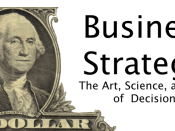Over the years different organisations have to develop strategies to survive in an ever-changing business environment. Strategies exist at a number of levels in an organisation (Exploring Corporate Strategy - Johnson and Scholes). Every organisation has a strategy at anytime, although they may not used the word deliberately. If these businesses are to become successful, then innovation and change must be at the heart of their strategic management. Exploring Corporate Strategy (Chapter 2), warned that the ' take-for-granted' assumptions in organisations are likely to 'build' an organisation to the need for change and how new strategies could be developed (Ambroshini with Johnson and Scholes 1998).
So the big question is 'What is Strategy?'
Strategy is a term that comes from the Greek strategia, meaning generalship. Different academics have come up with different definitions for the word 'strategy'. Mintzberg (1979) suggested that the term 'strategy' has been defined in a variety of ways but always with a common theme.
He has five definitions for strategy, which he calls the 5 P's.
Strategy as a Plan where some sort of consciously intended course of action, or a guideline to deal with a situation.
Strategy as a Ploy that involves scheming and plotting to achieve an objective, often to fool or outwit an opponent or competitor.
Strategy as a Pattern in behaviour or ways either deliberately or not.
Strategy as a Position, a concept that stresses goal setting and objectives.
Strategy as a Perspective that is a set of options and concerns that maybe unspoken but defines how the organisation operates.
Trgoe and Zimmerman (1980), defined strategy as a "the framework which guides those choices that determine the nature and direction of an organization." Hofer (1978), definition of strategy is somewhat different. His definition refers to strategy as "the basic characteristics of the...


